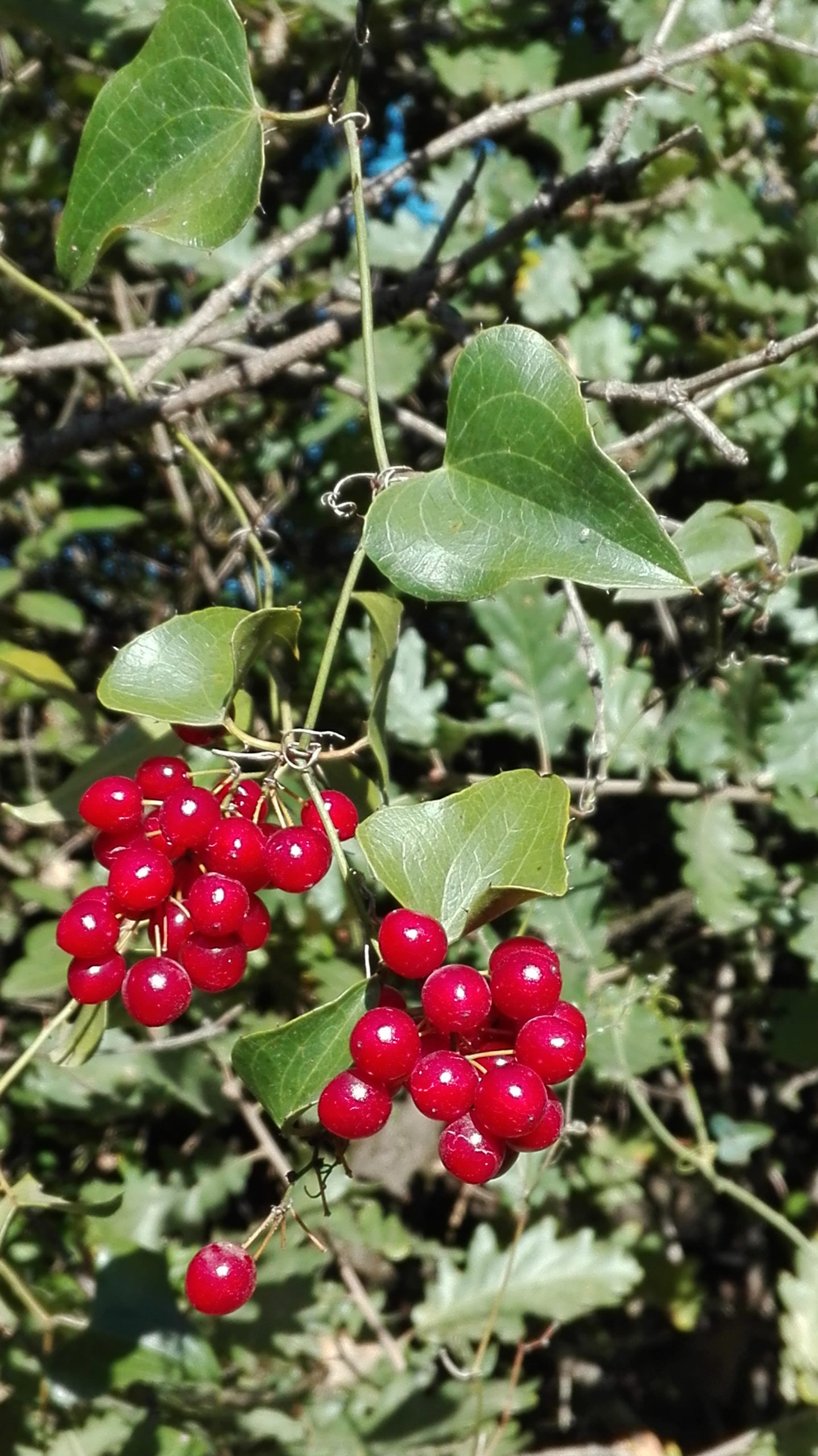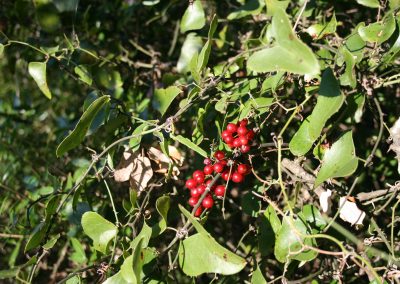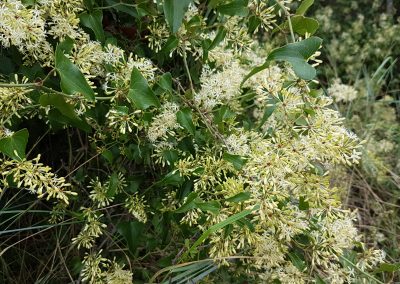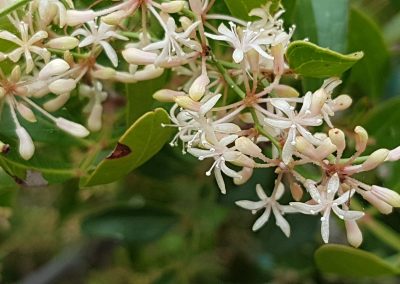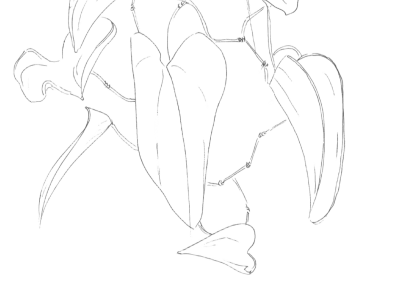Smilax aspera
Scientific description
Taxon: Smilax aspera
Class: Monocotyledon
Subclass: Liliidae
Order: Liliales
Family: Smilacaceae
Common name: Rough bindweed, European sarsaparilla
Origin:
Mediterranean region.
Description:
Climbing subshrub with thin, spiny stems. Leaves alternate, heart-shaped, leathery, glossy, sometimes white-spotted, with spiny margins. Simple tendrils aid attachment. Yellow-green flowers in umbels bloom August–October. Red berries follow flowering.
Propagation:
By seeds (from berries) or rhizome division.
Ecology:
Found in warm, dry habitats: hedgerows, woodland edges, Mediterranean scrub, up to 800 m altitude.
Uses:
Traditionally used as a sudorific and depurative for skin diseases and rheumatism.
Threats:
Hardy and widespread species, classified as Least Concern.
Taxon: Smilax aspera
Classe: Monocotylédones
Sous-classe: Liliidées
Ordre: Liliales
Famille: Smilacacées
Nom commun: Salsepareille d’Europe, Liseron épineux
Origine:
Pourtour méditerranéen.
Description:
Sous-arbrisseau grimpant à tiges fines et épineuses. Feuilles alternes, cordées, coriaces, brillantes, parfois tachetées de blanc, avec marges épineuses. Vrilles simples pour l'accrochage. Fleurs jaune-verdâtre en ombelles d’août à octobre. Baies rouges après floraison.
Multiplication:
Par graines contenues dans les baies ou par division des rhizomes.
Écologie:
Milieux chauds et secs : haies, lisières, maquis méditerranéen, jusqu’à 800 m.
Utilisation:
Sudorifique et dépurative traditionnelle, utilisée contre maladies de peau et rhumatismes.
Menace:
Espèce commune et robuste, classée en préoccupation mineure.
Taxon: Smilax aspera
Clasă: Monocotiledonate
Subclasă: Liliidae
Ordin: Liliales
Familie: Smilacaceae
Nume comun: Sarsaparilla europeană
Origine:
Regiunea mediteraneană.
Descriere:
Subarbust cățărător cu tulpini subțiri și spinoase. Frunze alterne, cordiforme, coriacee, lucioase, uneori pătate cu alb, margini spinoase. Cârcei simpli. Flori galben-verzui în umbele, august–octombrie. Fructe roșii.
Propagare:
Prin semințe (din bace) sau divizarea rizomului.
Ecologie:
Habitate calde și uscate: garduri vii, margini pădure, vegetație mediteraneană, până la 800 m.
Utilizare:
Folosit tradițional ca sudorific și purificator, pentru boli de piele și reumatism.
Amenințări:
Specie comună, fără amenințări majore, risc scăzut.
Ταξινόμηση: Smilax aspera
Κλάση: Μονοκοτυλήδονα
Υποκλάση: Liliidae
Τάξη: Liliales
Οικογένεια: Smilacaceae
Κοινή ονομασία: Σμίλαξ η τραχεία
Προέλευση:
Μεσογειακή περιοχή.
Περιγραφή:
Αναρριχώμενος θάμνος με λεπτούς, αγκαθωτούς βλαστούς. Φύλλα καρδιόσχημα, σκληρά, γυαλιστερά, με αγκάθια στα άκρα. Απλοί έλικες. Κίτρινο-πράσινα άνθη σε σπονδύλους, Αύγουστος–Οκτώβριος. Κόκκινες ράγες μετά την ανθοφορία.
Πολλαπλασιασμός:
Με σπόρους από τους καρπούς ή με διαίρεση ριζωμάτων.
Οικολογία:
Ξηρά και ηλιόλουστα περιβάλλοντα, θάμνοι, φράχτες και μακί, μέχρι 800 μ.
Χρήση:
Παραδοσιακό φάρμακο για εφίδρωση και αποτοξίνωση. Χρήση για ρευματισμούς και δερματοπάθειες.
Απειλές:
Κοινό και ανθεκτικό είδος. Χαμηλού κινδύνου.
Creative writing inspired by Smilax aspera
Sarsaparilla
Once upon a time, in a dense and mysterious forest, there was a plant called “Sarsaparilla”. Few people knew its name, but those who did remember its magic and secrets.
At first glance, sarsaparilla looked like a simple climbing vine, twisted and fragile, wrapping itself around trees.
One day, a young herbalist named Elias, curious to discover new plants with mysterious properties, decided to explore the forest. He had heard about sarsaparilla, but no one had ever ventured to look for the roots, as rumors were rife.
It was said that anyone who dared disturb this plant risked awakening an ancient, powerful and sometimes dangerous power. But Elias, determined to unravel this mystery, set off into the heart of the forest. As he walked, a strange feeling came over him. The air was charged with the sweet, earthy scent of roots, and every step seemed to bring him closer to something great and unspeakable.
Suddenly, he caught sight of the sarsaparilla, hidden under the shadows of the tall trees. It seemed almost alive. Elias reached out and touched one of its stems. At that moment, a strange warmth spread through his hand, and the vine began to twist, forming an intricate pattern around him and whispering, “I'm older than the world itself, but my secrets are not only remedies for the body, they also heal the soul. Those who respect and understand me discover that I weave bonds between beings, whether human or not”.
Elias realized that he had found something greater than a simple plant. He had discovered a deep connection with nature, an ancient wisdom he had never imagined. From that day on, he often returned to see the sarsaparilla, learning its secrets and sharing his own discoveries with it.
As the years passed, Elias became a renowned herbalist, known not only for his remedies, but also for his ability to heal hearts and souls. And every time he told his story, he always mentioned this plant, sarsaparilla.


